Berlin, a city steeped in history and culture, is an exciting place to explore through food. The city’s division during the Cold War into East and West Berlin fostered distinct gastronomic traditions, each reflecting its unique socio-political environment. In this exploration, we delve into six emblematic dishes—three from East Berlin and three from West Berlin—that not only tantalize the taste buds but also narrate the rich tapestry of Berlin’s history.
Berlin’s division was one of the most tangible symbols of the Cold War, a city split not just by ideology but by concrete, barbed wire, and political tension. Let’s catch you up:
Post-WWII and the Emergence of Two Berlins (1945-1949)
After World War II, Germany was carved up by the Allied powers (US + European friends) into four occupation zones controlled by the U.S., U.K., France, and the Soviet Union. Berlin was an interesting case, because it was entirely surrounded by East German territory, but since it was the capitol it was divided as well into four zones.
The ideological and political rift (see: communism and the Cold War) between the Soviet Union and the West deepened, tension for control of Germany built, culminating in the formation of two separate German states in 1949: East and West.
East Germany was known as the GDR – German Democratic Republic, a communist state controlled by the Soviet Union. The West was called the FRG, the Federal Republic of Germany, supported by the United States and its allies. As communism began to struggle to compete economically on the world stage the East German state grew poorer and the divide between the East and West deepened.
The capitol city itself was split into West Berlin, a Western-aligned enclave inside communist East Germany, and East Berlin, which became the capital of the GDR. The economic disparity meant that inside the West Berlin bubble there was often plenty, including meat and liquor, supplied by shipments from the West, while just beyond the wall East Germans struggled for basics.
The Berlin Wall and the Height of the Cold War (1961-1989)
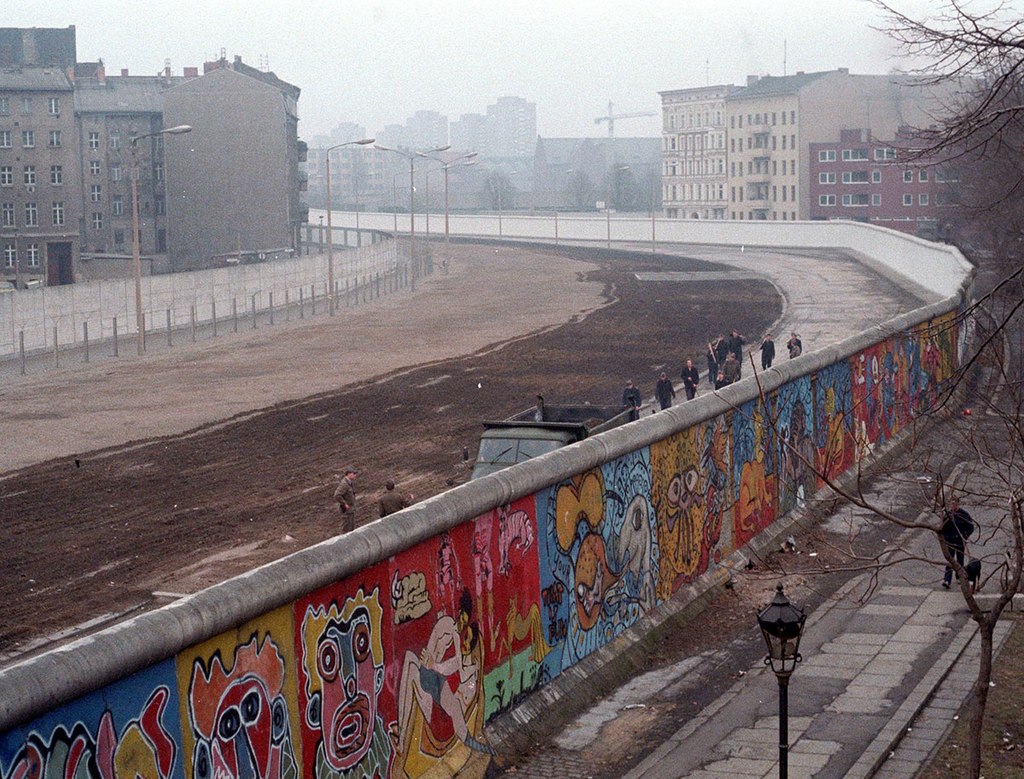
Between 1949 and 1961, an estimated 2.7 million East Germans defected to the West, mostly through Berlin. The East German government, fearing mass “brain drain”, constructed the Berlin Wall in August 1961. It was a physical and psychological barrier, stretching 155 km (96 miles) around West Berlin, with watchtowers, guards, and a “death strip” to prevent escapes. Many tried to escape over the wall and were shot down.
For nearly three decades, the wall was the defining image of divided Germany. While West Berlin flourished under capitalism with its thriving arts scene and modern infrastructure, East Berlin remained under heavy state control, with food shortages and surveillance by the Stasi (East German secret police).
The food in East Germany became heavily influenced by the Soviet Union and by the need to conjure up meals with little in the pantry – the West, in contrast, had access to Western European resources and retained some of its more traditional dishes.
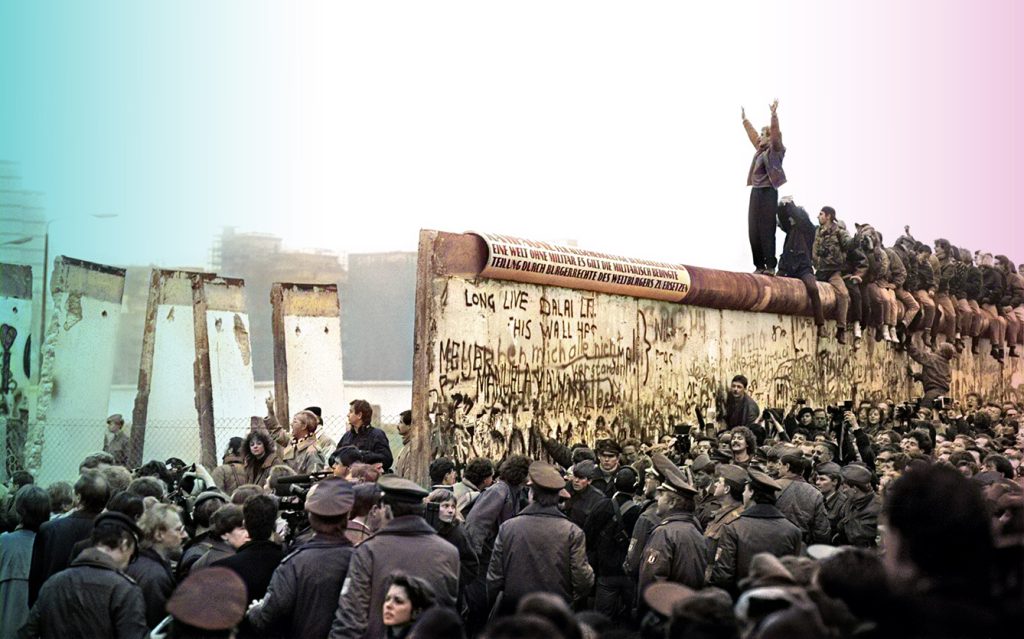
The Fall of the Wall (1989-1990)
By the late 1980s, the Soviet Union, under Mikhail Gorbachev, and with mounting pressure from both inside and outside the country, introduced policies of glasnost (openness) and perestroika (restructuring), leading to reform movements across Eastern Europe. Mass protests in East Germany, coupled with political changes in neighboring countries, pushed the GDR to relax travel restrictions.
On November 9, 1989, after a botched government announcement, thousands of East Berliners flooded the border crossings. Overwhelmed guards opened the gates, and citizens from both sides celebrated as they tore down the Wall. This moment paved the way for German reunification on October 3, 1990, ending decades of division.
Today, you can visit preserved sections of the Berlin Wall at the East Side Gallery, and also at the Berlin Wall Memorial, or visit Checkpoint Charlie – the site of the most famous border crossing between East and West where USSR and American tanks faced off in 1961 (tip – the original checkpoint booth was relocated to the Allied Museum).
Neighborhoods in East and West Berlin still have unique flavors and traditions that were shaped by these decades of divide. It’s a truly fascinating place to explore with this context in mind. Here are the 3 East and 3 West dishes that we at Cerca feel defined this Cold War divide:
3 East Berlin Dishes
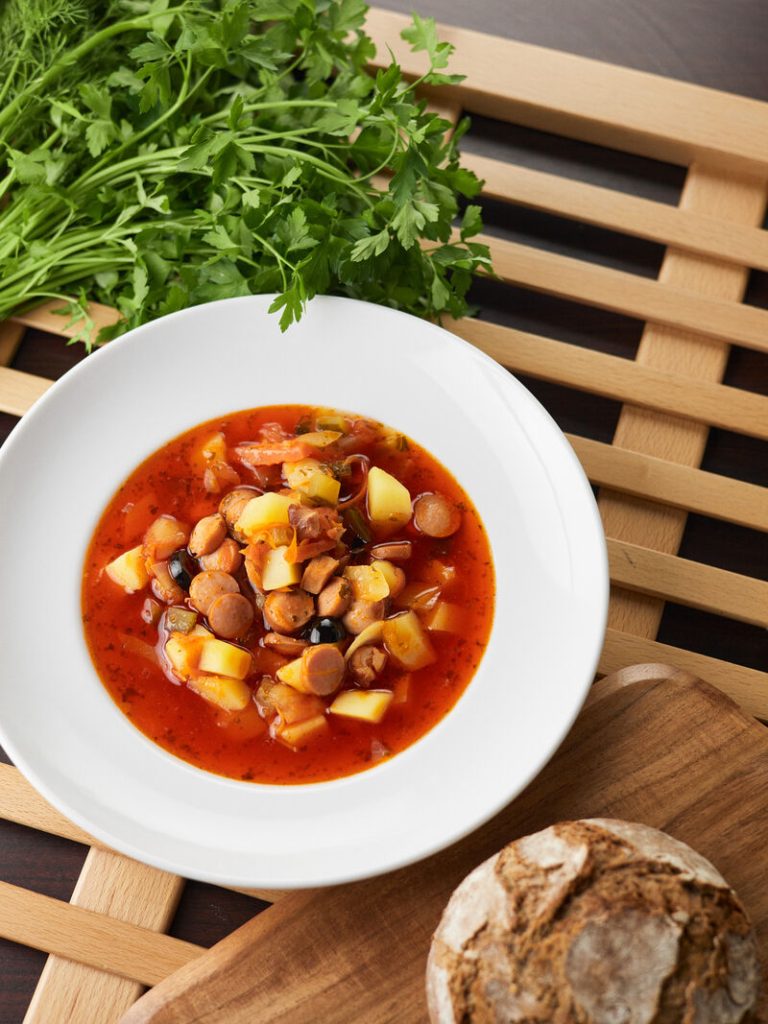
1. Soljanka
Originating from the Soviet Union, Soljanka became a staple in East Germany’s culinary scene during the GDR era. This hearty soup is a medley of meats—such as sausages, ham, or beef—simmered with pickled cucumbers, tomatoes, onions, and a blend of spices, resulting in a tangy and warming dish. Its popularity surged due to the availability of preserved ingredients, making it a practical choice during times of scarcity.
It reflects how East Berliners adapted Russian cuisine to create dishes that resonated with their palate and circumstances. Smoked meats like Jagdwurst (a type of German bologna) became a staple addition, because the state-run meat packing plant provided more processed meats as staples in the diet – this gave the soup a distinctly smoky, hearty flavor. Additionally, more tomato and paprika was added, and less lemon – which was not common in East Germany, and pickled cucumber was substituted for the traditional olives. Today, Soljanka serves as a nostalgic reminder of East Berlin’s past, often enjoyed in traditional eateries that preserve the city’s heritage.
Where to Taste:
Pelmennaia – A traditional Russian bakery and cafe, with pelmeni and wareniki, and Solijanka. Plus a very old-school East German habit of not having menu items in stock!
Pasternak Restaurant in the charming old-East Berlin neighborhood of Prenzlauer Berg often has a version of Solijanka on the menu, such as a one made with smoked ribs and sausage. Check ahead to be sure.
2. Ketwurst
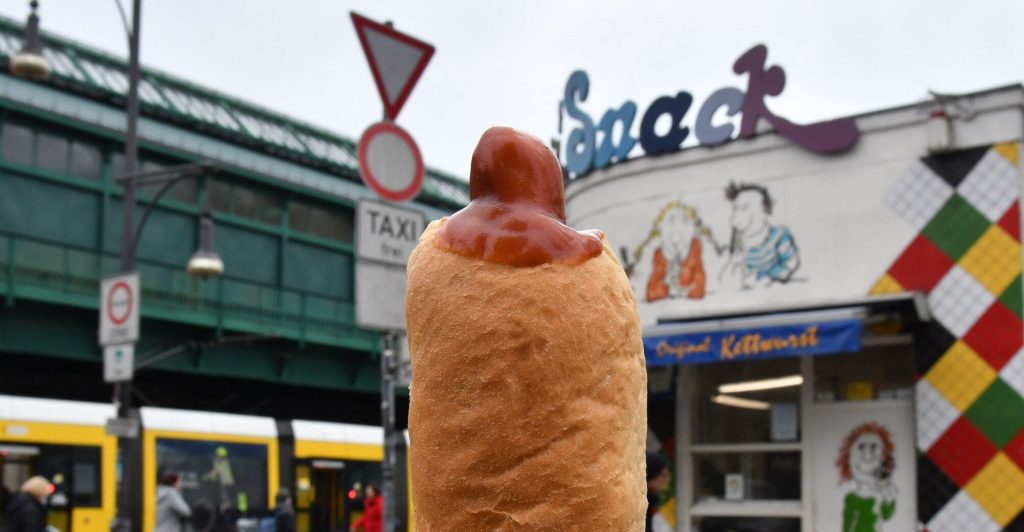
The Ketwurst, an East Berlin invention, is a unique take on the hot dog. Developed to provide a quick and affordable snack, it features a sausage (usually bockwurst – pork or veal with herbs and spices – again, processed meats being cheaper and more easily preserved) inserted into a specially baked roll, and filled with ketchup. The name “Ketwurst” combines “ketchup” and “Wurst” (sausage).
Created to mimic Western fast-food trends, the Ketwurst represents East Berlin’s attempt to offer its citizens a taste of global culinary trends and create a filling snack for a communist society workforce. It became a popular street food, and while there are not near as many Ketwurst stands today, you can still find it lurking on traditional menus.
Where to Taste:
Alain Snack – this Prenzlauer Berg hotdog stand dates back to East Berlin times and still serves Ketwurst, plus they’ve added a vegan variety. Find it at: U-Bhf Schoenhauser Allee 116 a, 10437 Berlin.
3. Grüne Soße (Green Sauce)
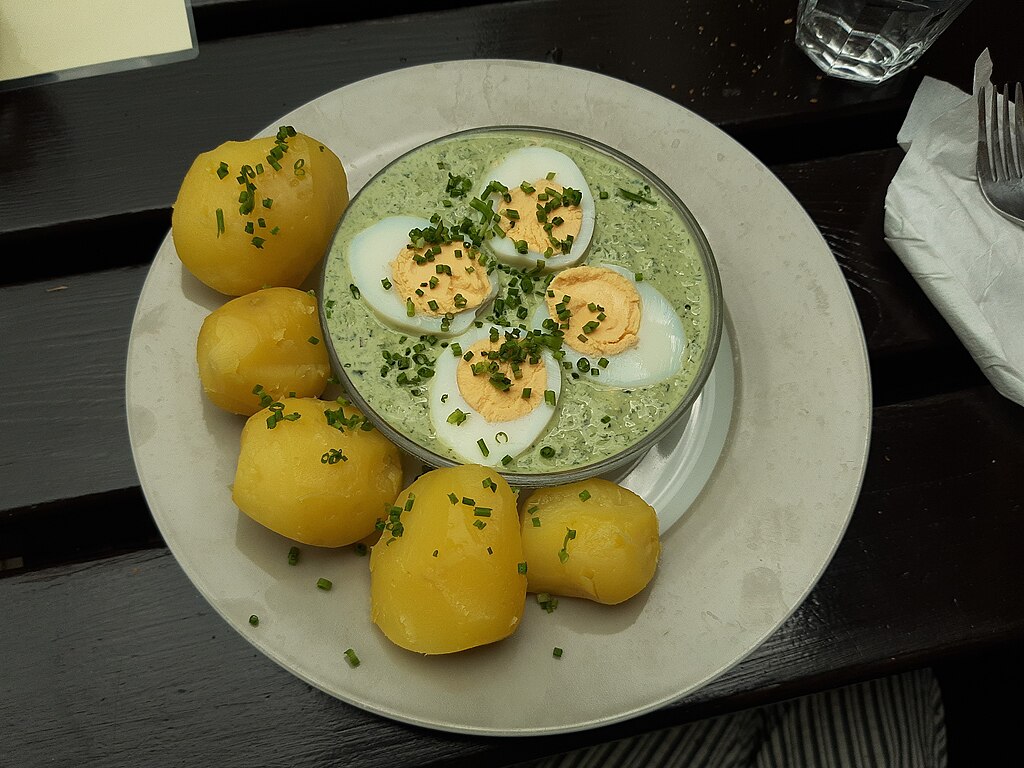
Though originating from Frankfurt, Grüne Soße found its way into East Berlin’s kitchens, especially during the spring and summer months. This cold sauce comprises a mixture of seven fresh herbs – all of which could be found growing in and around Frankfurt (including sorrel, parsley, chives and chervil), blended with sour cream or yogurt, and typically served with boiled eggs and potatoes. Its refreshing taste and simple construction made it a favorite during warmer seasons. There is even a Green Sauce Festival in Frankfurt.
Where to Taste:
The Bistro Mainhattan, a Hessian State restaurant, has a beautiful green sauce served over eggs and potatoes.
West Berlin Specialties

1. Currywurst
Perhaps the most iconic Berlin street food, Currywurst originated in West Berlin in 1949. Herta Heuwer, a resourceful snack bar owner, concocted a sauce using ketchup, Worcestershire sauce, and curry powder, which she poured over grilled pork sausage. This innovative combination quickly became a beloved fast-food staple for hungry construction workers in Charlottenburg in West Berlin after the war.
Currywurst embodies post-war Berlin’s spirit of innovation and resilience. It reflects the city’s openness to global influences, blending German sausage with exotic spices. Today, Currywurst stands are everywhere, a great example of Berlin’s growing street food culture.
There is today almost nothing more German than Currywurst!
Where to Taste:
For a classic Currywurst experience, visit Curry 36, renowned for serving this spicy delicacy to locals and tourists alike.
Perhaps the most iconic currywurst spot in all Berlin, Konnopke’s Imbiss has been serving sausages from underneath a subway overpass since 1930. Somewhere around 1960 they added Currwurst to the menu and it became the “thing to get”.
2. Berliner Pfannkuchen (Berlin Pancake)

Known elsewhere in Germany as “Berliner” and in the U.S. as “jelly doughnuts,” these sweet treats trace back to the 16th century. They are deep-fried yeast dough pastries filled with jam or marmalade and dusted with sugar. Today you can find them in a myriad of flavors and filling combinations as donut culture has exploded worldwide. The Berliner Pfannkuchen was originally a tradition for New Year’s Eve and carnival seasons.
Where to Taste:
Authentic Berliner Pfannkuchen at Bäckerei Siebert, Berlin’s oldest bakery (opened in 1906), it’s located in the East Berlin neighborhood of Prenzlauer Berg.
SugarClan: Find modern flavors and combinations like a donut based on a Swedish cinnamon roll and one filled with mango jam, plus traditional strawberry-jelly filled donuts.
3. Eisbein (Pickled Pork Knuckle)
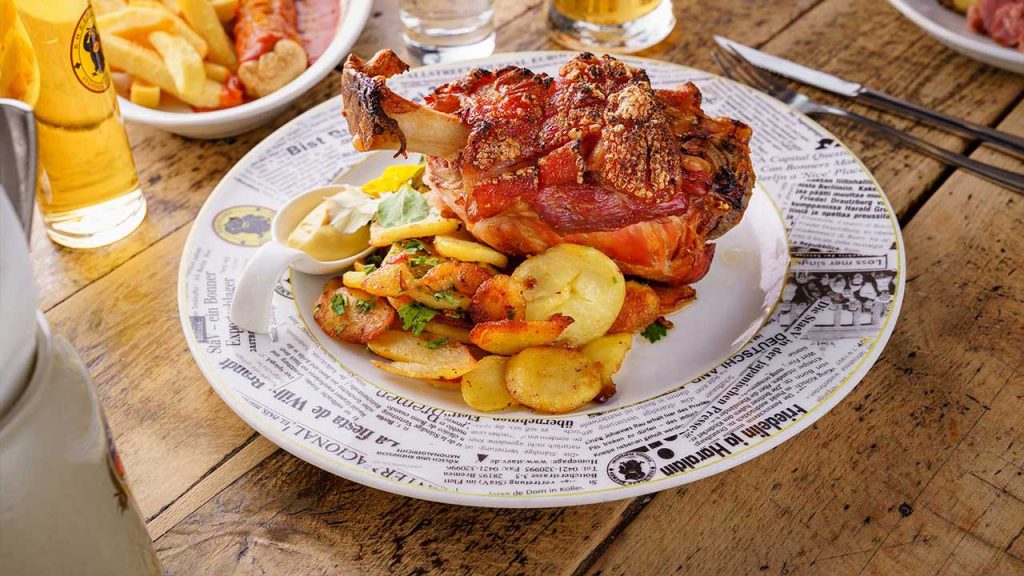
Eisbein, a traditional German dish, holds a special place in Berlin’s culinary repertoire. This heavy meal features a cured and boiled pork knuckle, typically served with sauerkraut and mashed peas. The name “Eisbein” translates to “ice leg,” possibly referring to the dish’s popularity during colder months or the bone’s resemblance to ice skates – legend has it that poor local children used to use the bones as exactly that.
Where to taste:
Max und Moritz – a historic Berlin inn (1902) in the trendy neighborhood of Kreuzberg, the pub serves an extensive German beer menu and a host of traditional dishes, including Eisbein. Served in the traditional style with mashed peas, sauerkraut, boiled potatoes and mustard.
Centrally located in Mitte, My StäV serves pork knuckle updated – grilled with fried potatoes. You can also find a currywurst and a hearty soljanka on the menu, along with traditional German black pudding.
A few more East vs West dishes to seek out? We got you:
Jägerschnitzel – The GDR version is very different from its West German counterpart. While the Western-style is a veal or pork cutlet with mushroom sauce, in the East, it was made with breaded and fried Jagdwurst (a type of German bologna or mortadella – as preserved meats were far more common and fresh meat rare and expensive), served with a tangy tomato sauce and Spirelli pasta (spiral noodles).
Würzfleisch is a small, baked dish of shredded meat (usually pork or chicken), mixed with a creamy white sauce, Worcestershire sauce, and baked with cheese on top. It’s served with a squeeze of lemon and a side of toast or baguette. The dish has Russian origins as “zharkoe”, and was used to stretch tinned or canned meat. You can find it today in pubs as an old-school bar snack.
Sauerbraten is Germany’s national pot roast, made from beef (or sometimes pork) marinated for several days (usually around 5) in vinegar, red wine, and spices, then slow-roasted to tender perfection. It’s typically served with red cabbage, potato dumplings, and a rich gravy. Originating from Rhineland, Bavaria, and Franconia, Sauerbraten was a Sunday meal tradition in West Germany.